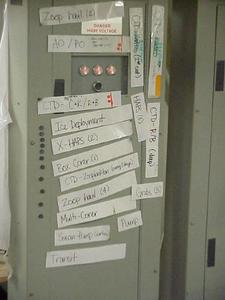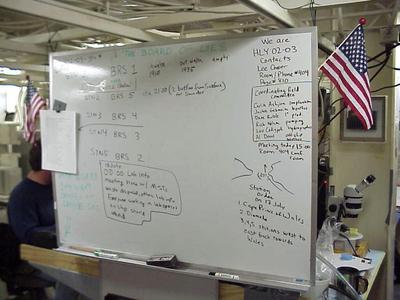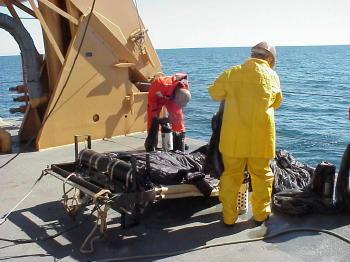18 July, 2002
My head is spinning! As we worked through a station
today, I tried to gather as much information as
possible about each sampling procedure that happened.
I found that I understood most of the work, but got
lost in some of the fine details of analysis.
Throughout the cruise, I will talk to each team of
scientists again (there are 12-14 different projects
going on depending on how you count) and report back
to you about their work. I also spent time learning a
bit about my own responsibilities once we arrive at a
station where we sample the mud for bottom organisms.
In the morning, we all heard a briefing from the MSTs
(coast guard crew who are considered marine science
technicians) about information for those using the
science labs. While at sea, everyone must take great
care with waste disposal, general cleanliness and
handling of hazardous materials. One of the MSTs, the
marine mammal specialist asked us to fill out a report
whenever we spot marine mammals. It’s all a part of a
National Science Foundation survey. Throughout the
day, we were surrounded by what we believe to be gray
whales. Identification is tough without binoculars
because many of the key characteristics are difficult
to see at a distance, especially when the whales
surface so briefly. Gray whales are the only
benthic-feeding whale. They dredge through the mud on
the bottom and filter out tiny organisms with their
baleen (bony material which forms into comb-like
structures growing from the upper jaw). In addition
to the numerous whales we spotted several common
murres flying by. The murres belong to a group of
birds which includes auks and puffins. The
classification family is Alcidae, the group often
called the “penguins of the north” because of their
black and white color and their set back legs which
make them look upright when on land. Remember that
true penguins don’t live in the Arctic.
A ship-wide fire drill in the early afternoon took
many scientists away from the lab and their work.
Others were concerned that the drill would interrupt
our next station, scheduled to begin at 2 PM with a
service cast. Below you’ll see a picture of the
“Board of Lies.” Someone’s’ sense of humor came into
play when writing the title. Despite the best of
intentions, it is nearly impossible to accurately
predict when things will happen. There are simply too
many variables involved. The scientists who do
research at sea are used to the term “stand by to
stand by.” That means that you need to be ready to be
ready! The service cast that was scheduled for 2 PM
(and re-scheduled for several times after that) was
completed at 10 PM!
An interesting event occurred this morning; when we
crossed the Arctic Circle. The Arctic Circle is the
most southerly point of 24 hour daylight on June 21.
It is at just above 66 degrees north latitude.
Although we are not in total 24 hour daylight, the sun
is lighting up my room right now at 10:45 PM. The sun
will set briefly, but it never gets dark. Somehow
that makes it easier to do those late night stations.
One final note –- it really is a small world. After
dinner I met Chris Martin, a crewman from Mississquoi,
Vermont, a town close to Colchester where I live. We
had great fun identifying all the people we knew and
sharing stories of home.

These magnetic strips are used to post onto the "Board of Lies" to let us know when we will start our next station (that's the part the always seems to change) and what sampling we will do once there.

Scientists do have a sense of humor. Because the posted schedule changes so frequently, it's called "the Board of Lies." Even though the exact times are rarely correct, everyone must be ready to do their jobs at the scheduled times.

This piece of equipment is called a MOCNESS. It stands for Multiple Opening and Closing Net Environmental Sensing System. It sets out 9 nets at a time which are dragged through the water to collect plankton (tiny organisms that drift in the water). A computer controls the opening and closing of the nets so samples can be taken at different depths.
Contact the TEA in the field at
.
If you cannot connect through your browser, copy the
TEA's e-mail address in the "To:" line of
your favorite e-mail package.
|
